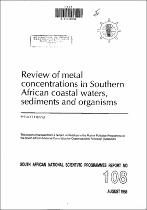 ResearchSpace
ResearchSpace
Review of metal concentrations in Southern African coastal waters, sediments and organisms
JavaScript is disabled for your browser. Some features of this site may not work without it.
- ResearchSpace
- →
- Research Publications/Outputs
- →
- Journal Articles
- →
- View Item
| dc.contributor.author |
Hennig, HF-KO

|
|
| dc.date.accessioned | 2008-08-12T09:57:24Z | |
| dc.date.available | 2008-08-12T09:57:24Z | |
| dc.date.issued | 1985-08 | |
| dc.identifier.citation | Hennig, HF-KO. 1985. Review of metal concentrations in Southern African coastal waters, sediments and organisms. National Scientific Programmes Unit: CSIR, SANSP Report 108, 1985, pp 143 | en |
| dc.identifier.isbn | 0 7988 3550 8 | |
| dc.identifier.uri | http://hdl.handle.net/10204/2352 | |
| dc.description.abstract | In this report Background levels and levels of metal accumulation in water, sediments and fauna were determined using a typical data set from South Africa-This was done to establish the extent and reliability of the available data and to identify any possible anomalies. A comparative study such as this contrasts regional metal values between various areas around South Africa and also allows international comparison. It is an extension of the philosophy behind the international Mussel Watch Programme and also serves as reference document for future studies. It demonstrates that in South Africa samples are usually taken from polluted areas ("hot spots") and huge gaps exist in the monitoring of coastal areas. Furthermore, the accumulation of metals by different animals does not necessarily depend on current environmental conditions. For instance, different species of limpets accumulated various metals at different rates even at the same geographical position (for example "spread of graphs" presented). Furthermore extrapolation of results from one region to another is not valid, even when working with the same species. The study also showed that no single indicator species should be used for all metals. Accumulation of specific metals may be highly correlated in one species, while other metals are not. For example in this review bivalves show no clear accumulation trend when one is attempting to establish baseline levels for zinc. Whelk species on the other hand show less inter-organism variation | en |
| dc.language.iso | en | en |
| dc.publisher | National Scientific Programmes Unit: CSIR | en |
| dc.relation.ispartofseries | CSIR | en |
| dc.subject | SANSP | en |
| dc.subject | Coasts | en |
| dc.subject | Metals | en |
| dc.subject | Oceans | en |
| dc.subject | Organisms | en |
| dc.title | Review of metal concentrations in Southern African coastal waters, sediments and organisms | en |
| dc.type | Article | en |
| dc.identifier.apacitation | Hennig, H. (1985). Review of metal concentrations in Southern African coastal waters, sediments and organisms. http://hdl.handle.net/10204/2352 | en_ZA |
| dc.identifier.chicagocitation | Hennig, HF-KO "Review of metal concentrations in Southern African coastal waters, sediments and organisms." (1985) http://hdl.handle.net/10204/2352 | en_ZA |
| dc.identifier.vancouvercitation | Hennig H. Review of metal concentrations in Southern African coastal waters, sediments and organisms. 1985; http://hdl.handle.net/10204/2352. | en_ZA |
| dc.identifier.ris | TY - Article AU - Hennig, HF-KO AB - In this report Background levels and levels of metal accumulation in water, sediments and fauna were determined using a typical data set from South Africa-This was done to establish the extent and reliability of the available data and to identify any possible anomalies. A comparative study such as this contrasts regional metal values between various areas around South Africa and also allows international comparison. It is an extension of the philosophy behind the international Mussel Watch Programme and also serves as reference document for future studies. It demonstrates that in South Africa samples are usually taken from polluted areas ("hot spots") and huge gaps exist in the monitoring of coastal areas. Furthermore, the accumulation of metals by different animals does not necessarily depend on current environmental conditions. For instance, different species of limpets accumulated various metals at different rates even at the same geographical position (for example "spread of graphs" presented). Furthermore extrapolation of results from one region to another is not valid, even when working with the same species. The study also showed that no single indicator species should be used for all metals. Accumulation of specific metals may be highly correlated in one species, while other metals are not. For example in this review bivalves show no clear accumulation trend when one is attempting to establish baseline levels for zinc. Whelk species on the other hand show less inter-organism variation DA - 1985-08 DB - ResearchSpace DP - CSIR KW - SANSP KW - Coasts KW - Metals KW - Oceans KW - Organisms LK - https://researchspace.csir.co.za PY - 1985 SM - 0 7988 3550 8 T1 - Review of metal concentrations in Southern African coastal waters, sediments and organisms TI - Review of metal concentrations in Southern African coastal waters, sediments and organisms UR - http://hdl.handle.net/10204/2352 ER - | en_ZA |





